FOLLIES: PAVILION DE LAC MARTIN
Many years ago, I had lunch with a friend who was redecorating her house. She had a beautiful English Country Manor style home and she was selling everything to start afresh with French antiques. Her designer had introduced her to an antiques dealer in Louisiana and she had just paid him a visit. Our entire lunch was spent with news of this antiquarian who lived in a tower, a follie, out in the country on Lake Martin.
He had built the house and it was unlike anything my friend had ever experienced. The tower had just one large room with 4 smaller rooms per floor and it was designed to authentically replicate life in early 18th century France. My friend’s eyes were still glazed over as she described how beautiful the tower was and how interesting her host was. His life was dedicated to the beauty and rarefied airs of French design. She described in detail how each plate, glass, light fixture, chair, curtain – everything was 18th century French.
As you might imagine, I was a willing hostage to her tales, and through the years I would think of her description of the follie and would just SIGH. SIGH.
If only…
Fast forward to last week while talking design with a Lafayette friend, the restaurant owner Andrea Veron, she mentioned an antique shop owner’s web site. I looked it up, and there was the same follie from lunch all those years ago.
Heaven.
I thought that perhaps, Mr. Robert Smith, the gentleman owner of both the antique shop “Au Vieux Paris Antiques” and the follie would allow me to write about his country home? Graciously, he did and so here we are.
Mr. Smith is a restoration consultant with a degree in architecture. His shop is located in compound of small 18th century houses off a country road in Breaux Bridge, Louisiana. The town is off I-10 between the larger city of Lafayette and the Atchafalaya Wildlife Refuge, on the way to New Orleans. Breaux Bridge is in deep Cajun country, and Mr. Smith is himself a native of Louisiana, a Creole, whose ancestors came from France to this very land generations and generations ago.
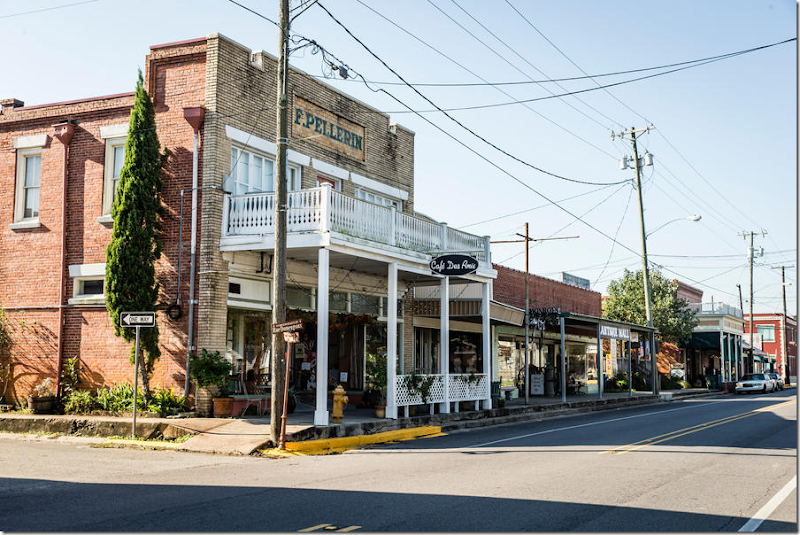
Breaux Bridge, Louisiana is a small town of 8,000. Called the Crawfish Capital of the World, its downtown consists of charming original buildings where you find the heart of Acadian Country.

The Teche bayou runs through the Breaux Bridge.

The Henri Penne house – the centerpiece of the 9 acre compound of “Au Vieux Paris Antiques” - was restored 40 years ago by Robert Smith. Smith has moved or built 9 buildings on the wooded site, including two houses and one outbuilding that he restored and which are all are listed on the National Register of Historic Places. The compound replicates what a French Creole plantation looked like in the 19th century.
Mr. Smith happily lived in his directiore Maison Dimanche (Sunday House) next to the shop in the Henri Penne house, but he had an idea brewing in his mind. He had visions of building a country house – away from the plantation – a quiet, personal space which would be entirely of his own design.
A Follie.

The Follie at Kew Gardens, England
It’s been 15 years since his follie was completed and Smith wrote about this anniversary on his blog – recalling the details of his tower’s construction.
Smith chose nearby Lake Martin to build on. It’s a lake, but it is also considered a swamp – and an official wildlife sanctuary. It is home to 1000s of birds, both migratory and shore, and it’s a bird watchers paradise.

And then, there are the alligators that nest, camouflaged, among the back trails. There are other more garden variety reptiles like snakes and lizards.

Living nearby the lake is nirvana to a wildlife and nature lover.

Robert Smith says of his property: “It has been a great joy to live in such an unusual home set in an equally unusual setting.”
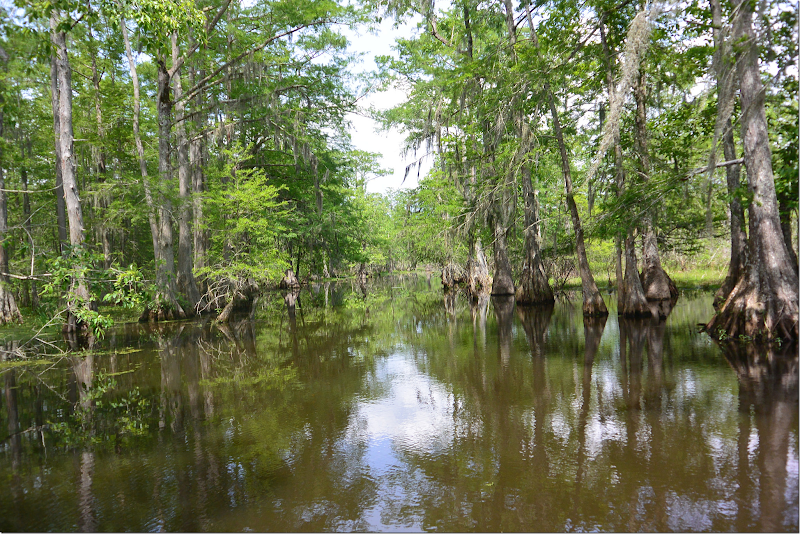
Living among all the nature – the alligators, rabbits, deer, raccoons, and birds – is like living in his own “Jurassic Park.”

Smith’s property has ten – 350 year old Live Oaks, each over 100 ft. tall! Here Smith stands in front of one of the massive oaks! Amazing!!
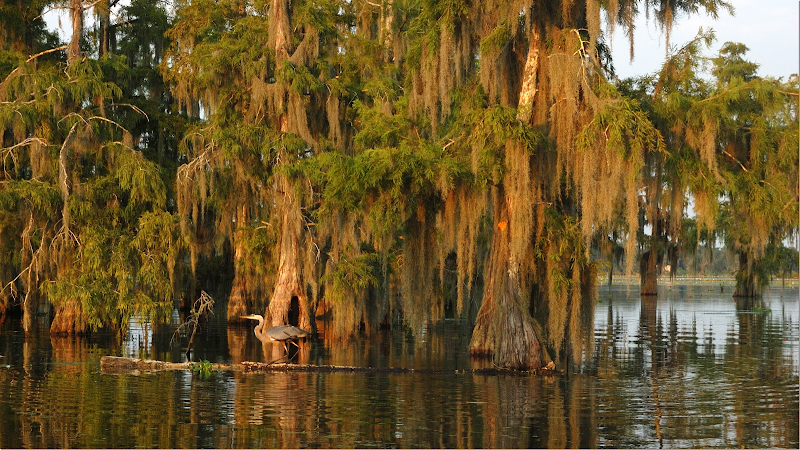
To Build a Follie:
First, what IS a follie? To quote M. Charles Ryskamp, Director of The Frick Collection, NYC, regarding 18th century French “follies:”
“Hours of idleness, the pursuit of pleasure and love by persons royal, noble, or other very rich, have in past centuries frequently resulted in astonishing buildings created for casual amusements. In France, these edifices are exemplified by a few surviving garden follies, and evoked in the letters and journals of those who built or visited such pavilions…”
When it came time to build Robert’s follie, the planning and construction phase lasted three years. The first year was taken up with planning and engineering studies. These studies were especially important because of how tall the tower is and the type of soil on the property. In the end, the concrete foundation piles were placed 26 feet into the ground and 15 truck loads of concrete were required.
Trees were carefully selected to be either saved or sacrificed and the road leading to the follie needed to be built.
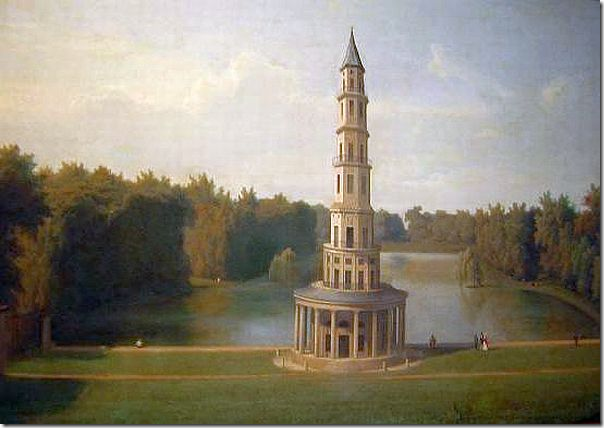
Next the building materials had to be purchased. Not just any materials, but antique materials, from France.
The contractor, Mr. Jim Armentor and his ten men crew, worked five days a week for 22 months building the tower. Smith himself worked on the tower every weekend with two men from his staff. The scaffolding reached 60’ tall and an outer staircase was also built to OSHA specs. Cranes were on site the entire time.

The construction was mostly problem free, until the masonry moat was to be built. Finding an expert on moat building was fruitless, but then Smith happened upon the restoration of an ancient moat at Chateau Sully in Bourgogne, France. He studied the techniques used there and reused them in Louisiana.
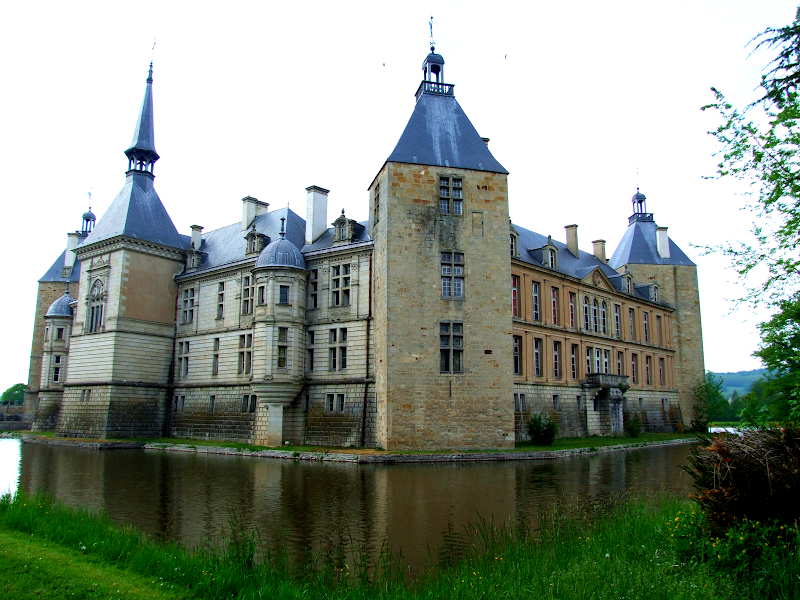
Chateau Sully & its moat whose restoration techniques were used at the follie.

The style of the tower is Regence/Louis XV, circa 1735. Most of the furnishings and decorative objects are the same era with some older Louis XIII and XIV pieces, just as there would have been in a true 18th century French house.

Robert named his follie “Pavilion de Lac Martin.” The proportions are classic and with all four sides lighted by huge French doors, it is a “lantern.” Its sophistication is meant to contrast with the wild nature of its swamp setting.

To make the follie a realistic 1735 replica, 18th century French doors, boiserie, parquet de Versailles and hand made terra cotta tiles, hand forged iron hardware and stone mantels were employed in the construction.
Most beautiful are the antique wood ceilings of “plafond a la francaise” design, as well as the antique wavy glass that are used in the windows.
The height of the tower and the numerous glazed doors allows the views of the lake and the landscape to be fully appreciated from inside.

As Mr. Smith says “having the “Bon Gout” of Mother Nature’s treasures, as well as the “Bon Gout” of the architecture and furnishings of early 18th Century France joined together in one living environment has been a continuous joy for the last 15 years for which I am very grateful!”
Let’s visit the Pavilion de Lac Martin!

Barely visible in the center of the trees is Pavilion de Lac Martin as seen from the lake.

At Pavilion de Lac Martin, gravel paths flanked by Anduze pots with box lead to the house.

The pavilion is four stories tall with a roof top terrace and a basement. A true lantern, you can see through the windows of the main one-room deep house to the back yard.
Lanterne means “see through.” In architecture, a room with windows on each side.

Notice how the tower is perfectly sited between the trees. It is truly a follie in the garden.

The gravel path leads up the masonary steps to the bridge over the moat. Topiary in Anduze pots flank the entry.

The view from the front terrace looking back towards Lake Martin. Moss grows on old Live Oak and Cypress trees, making the property so atmospheric.
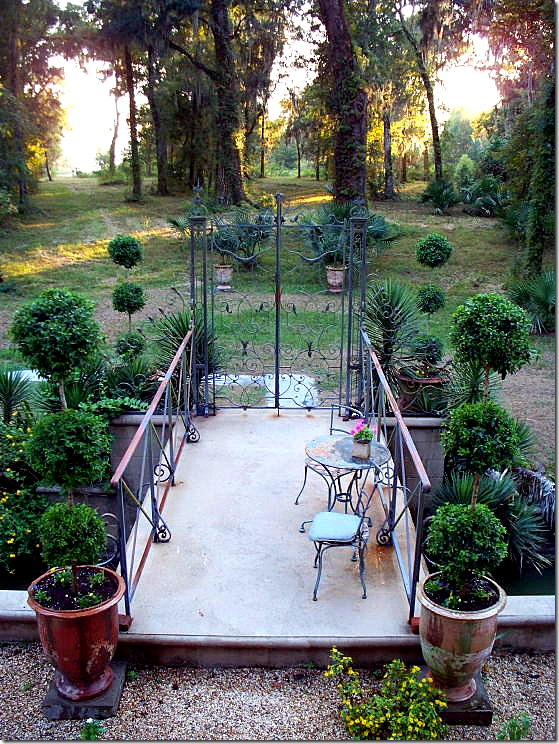
The bridge over the moat.

Up the front masonary steps, past the moat, a fountain greets you. Love the gravel terrace.

A view from the tower down to the fountain and the moat. Notice how the foliage grows up through the gravel terrace.

Here you can see how the moat encloses the tower. Oeil-de-boeuf windows flank the front door, along with wood shutters.

A beautiful view of the arched bridge, reflected in the water. At the corner, plants and flowers grow over the walls, softening the look.

Another view of the moat.

The right side of the tower. Each floor has one large room with four smaller rooms – with windows or French doors on all four sides. Notice the trellis pyramids on the back side of the terrace which hide the three air conditioner condensers.

A rare view of the 4th side of the tower. You can see both trellis pyramids which were built to disguise the air conditioners!!
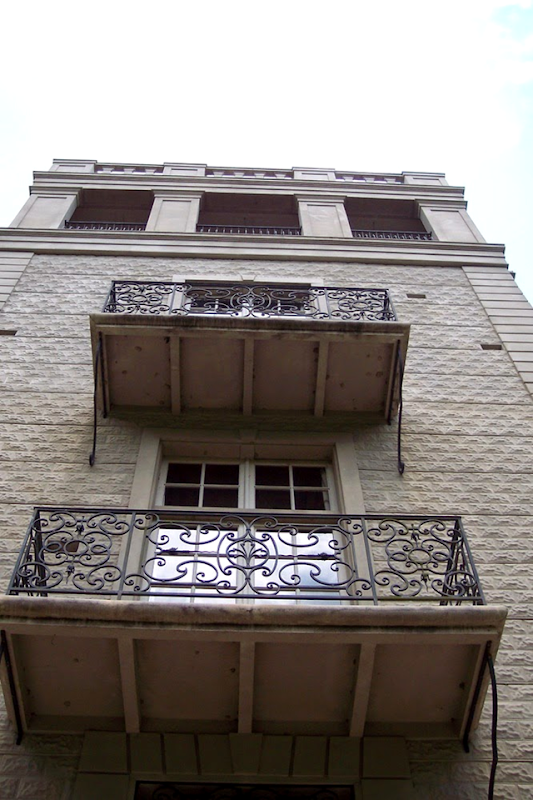
At the front side, each floor has a balcony.

Close up view of the gates.

Topiary in pots.

The basement level doubles as a guest room.

Storage hides behind curtains.
First Floor:

Here is a floor plan to give you an idea of how each level is designed. The windows are on each side, while the corners are used for the stairs, fireplace, laundry room/storage, and bathroom on this level. The four floors, with one room deep, total over 2,700 sq. ft. – to give you an idea of the size of each floor.

The beautiful dining room. Overhead hangs a crystal chandelier, with sconces on the wall. My favorite part of the tower (one of them!) is the way the ceilings were constructed using the plafond a la francaise method.
Basically, the French Ceiling is – joists that are the same width as the spaces between them. You see these ceilings in France, in houses and buildings. Even in apartments that have been completely updated, the owners will leave these gorgeous beamed ceilings as is.

The table set to overlook Lake Martin.
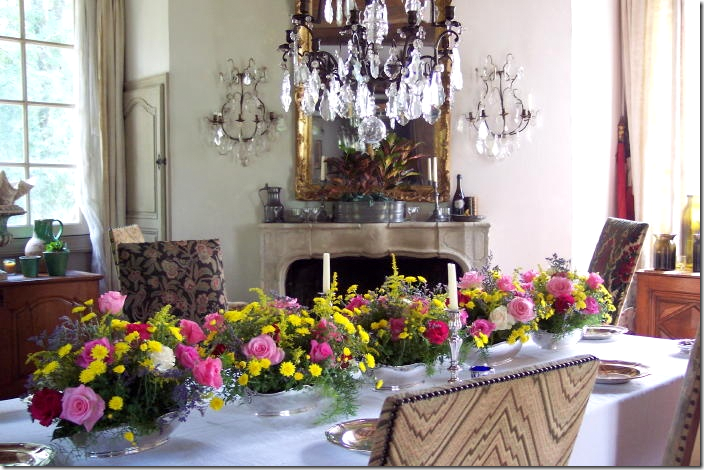
Here, a row of flowers decorate the long table, set with tapestry covered chairs.

A simpler setting for a brunch.

Notice the silverware is set European style.

Beautiful spring flowers reflected in the mirror.
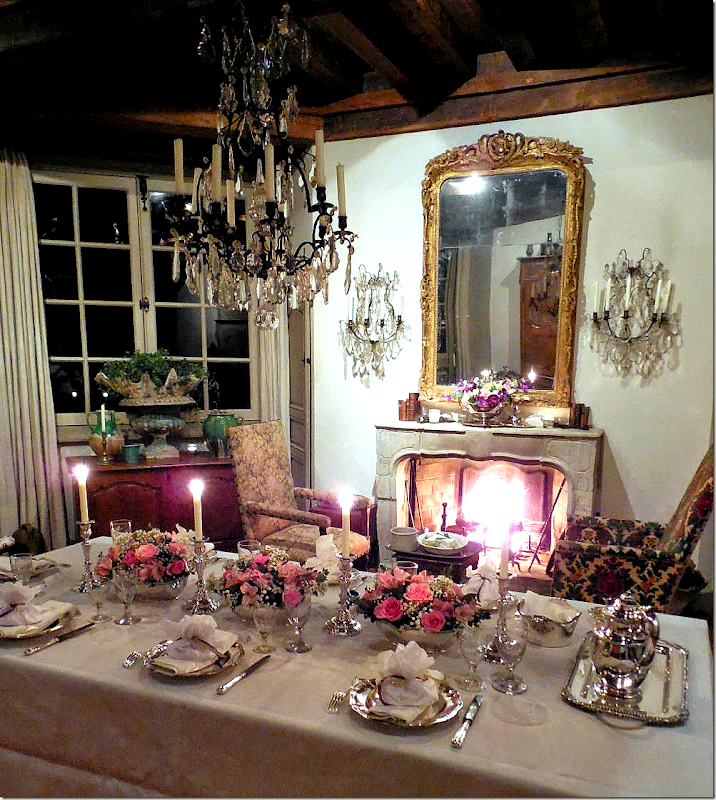
The chandelier and sconces are lit by candles, only. Here, a night time view of a dinner party with the roaring fire. Beautiful!

Two chairs are pulled up next to the mantel.

A closer look at the beautiful mirror over the mantel. Notice that ceiling beam!! Also, notice that there is no typical ceiling molding. Instead, the beams meet the walls. The ceiling is just fabulous.

Classic 18th C. handmade "red" terra cotta floor tiles are on the dining room floor. These tiles, along with yellow tiles, stone flooring, Parquet de Versailles, doors and fireplace mantles are all sold at Robert Smith’s shop – Pavillon Cote Sud.
Go HERE to read more about the shop.

The kitchen:

Hidden behind two corners on the dining room floor, is the small but fully functional kitchen.

Most interesting is this ‘buffet a deux corps’ opens up to the kitchen to allow for easy serving at parties. Ingenious!
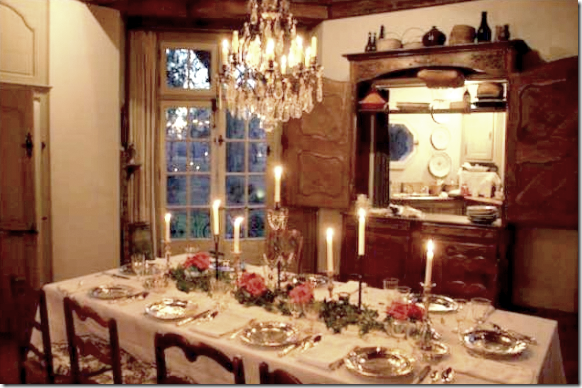
Another view of the kitchen with the open ‘buffet a deux corps.’ This would be a great idea to use in your own home, especially if you want an open bar.

Another ingenious detail is the dumb waiter that is installed in a corner on each floor and utilizes the ancient pulley system.
The Second Floor: Bedroom
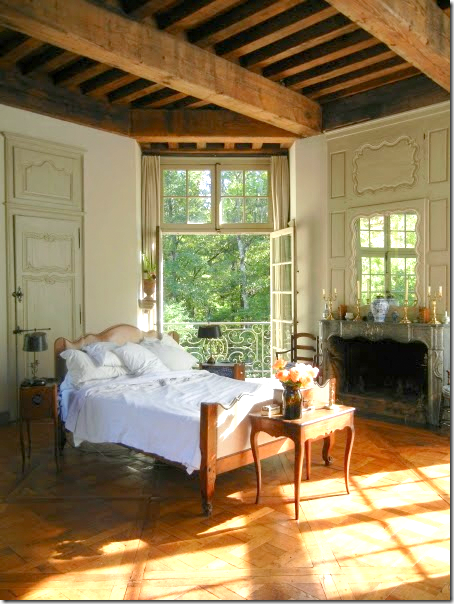
On the second floor is the master bedroom, seen here with the bed floating in the room. The walls are covered in antique boiserie. The floors are Versailles pattern parquet.

The other direction, facing a door with hand forged hardware. The balcony has the view of Lake Martin. The beamed ceiling is overhead – a rustic element juxtaposed against all the delicate Louis XV furniture.

Just beautiful. I love the reflection of the rustic beams mixed with the delicate beauty of the orchids.

The Louis XV Blue Turquin marble mantel with boiserie overmantel.

Notice the brick hearth – three levels of bricks. I love the construction of the fireplaces.
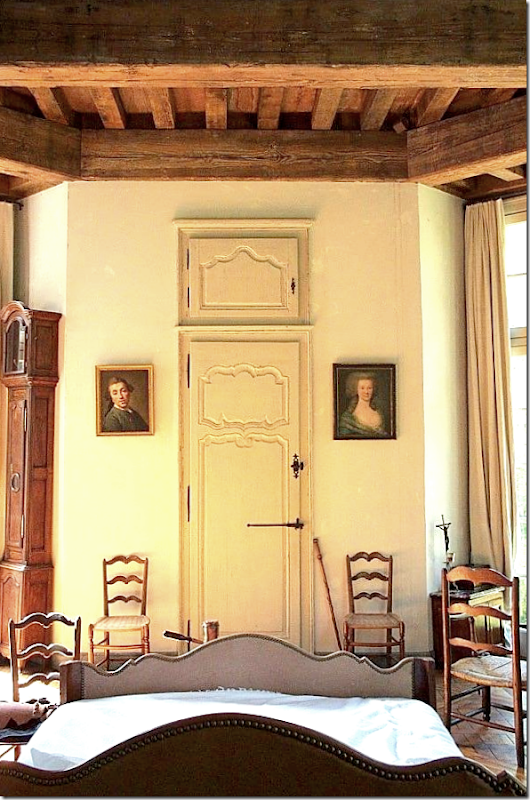
My favorite vignette - the door flanked by antique portraits!

A beautiful arrangement with windows and ceiling reflected in the mirror.

The Parquet de Versailles – this beautiful wood floor is also available at Pavillon Cote Sud.

The view of Lake Martin.

Dusk on the lake, from the bedroom balcony.
The Third Floor: The Living Room

Looking down at the living room filled with French Louis XV and Regence furniture.
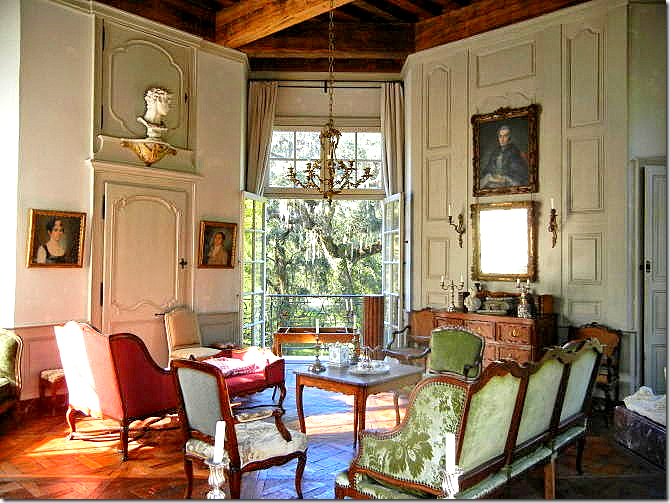
A beautiful view. Is this France? No?

Looking down at the marble fireplace.

Another vignette I love – the oval mirror with sconces and an oil painting above. Love!!!

The furniture is covered in a collection of pink and green silks.

Gorgeous!!!! Do you see the little alligator?!?
You can see the candles are lit nightly. While you don’t see it – there are 21st century necessities, like air conditioning, electricity, lights, fire and burglary detection and video surveillance cameras. Smith has hidden all evidence of anything that spoils the authentic look of his 18th century follie.

I love how Smith hangs the portraits over the mirrors. This way – the reflection of the mirror is at eye level, so you can enjoy it. Always remember the reflection when hanging a mirror. It’s as important as the mirror itself.

Notice the matching faux marbre baseboards and real marble mantel.

Another favorite vignette – the bust above the door with the gauche portraits at the side.
Fourth Floor: Sleeping Porch
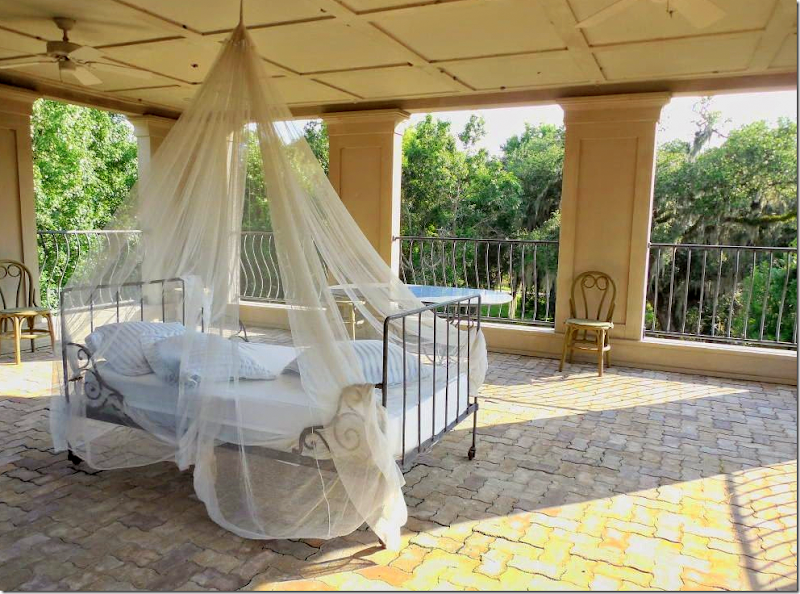
The top level is used as an outside sleeping porch and, also, for both entertaining and dining. The bed is fitted with necessary mosquito netting.
I suppose if the follie is ever sold and the new owners wanted more space, this level could be enclosed and become another bedroom or sitting room. Still, it must be a wonderful place to sleep in the spring and fall – and even a mild winter in Louisiana.

There is a fireplace, which really makes it a wonderful winter room. This is the French version of the fire-pit.

The fifth floor – or the top terrace is open to the view of lake. Imagine watching the migratory birds flying by or watching those who come to nest.

The sun bathes the tower in light.

A late fall view of the tower.
To Robert, a huge thank you for graciously opening up your house to Cote de Texas!
Thank you!!
And to further the dialogue, Mr. Smith has a list of books on Follies and French Design that he recommends. These are some of his favorites on this topic. Some are out of print, but I have found a source for each. To order any of the books, just click on the image.

















And finally, I hope you have enjoyed visiting Robert Smith’s vision. If you are in Louisiana, be sure to call his shop – to stop by.

To visit his shop’s - Au Vieux Paris Antiques – web site, go HERE.
To see a sample of the antiques at the shop, go HERE.















































































Yum! You really have an eye! This is just what I love. It's how we're planning to decorate the apartments in the middle of Carcassonne, France, that we're renovating. The ceilings are 14 feet high with moldings, which I love, though I also love the cozy rooms with wood beams.
ReplyDeleteJust FYI, it's spelled folie in French and folly in English. My Petit Larousse says this of folie: Petite maison de campagne où l'on se réunissait autrefois pour se divertir librement: small house in the country where one gathered in earlier times to freely distract oneself.
I suspect it comes from the sense of folie as an extravagance.
By contrast, a folly is built to decorate rather than as a country house. I wonder how/when the terms diverged.
We spend a lot of time on Lake Martin at my sister's lake house throughout the year but I've never heard of this place. We'll have to try and find it when out cruising on the pontoon.
ReplyDeleteImagination extraordinaire !
ReplyDeleteKaren
...glorious...simply glorious....blessings...laney
ReplyDeleteYou mention another buyer enclosing the top level open air bedroom. Monstrous action !
ReplyDeleteMoving into my ca. 1900 American farmhouse I decided to let the architecture of the house dictate lifestyle. The house is 1 story 4,000sf, with a central hall 9' wide x 50' long. Closets are good for its era. However, not what I was used to, have donated beyond anticipations, clothing, letting my home choose my wardrobe.
How I would love this Folly on Lake Martin. I shall have it, in imagination.
Bless this man for creating his Folly, and sharing.
XOT
My favorite of your posts Joni! Great detailing of this magical building and man. Our world needs more of this fun in architecture and more adventurous folks.
ReplyDeleteJoni, This is amazing! The home could easily be a chateau in France....beautiful.
ReplyDeleteYou make me gasp, you make me smile, you make me exclaim OMG!!! This was one of your OUTSTANDING!! Viva la follie!!! franki
ReplyDeleteJoni, your blog belongs in the the Smithsonian Institute. The research and the historic storytelling is beyond compare. Thank you, thank you for your blog!
ReplyDeleteThis is just F'ing incredible -seriously! the most interesting thing I've ever seen -thank you so much for sharing this! wow. Now I want to go visit -haha.
ReplyDeleteI was so disappointed that I knew all of the books though and own each one (even the rare small houses of versailles!). need to get to his shop. Love this 'little' house! just incredible.
This was a stand-out beauty of a post. Living also in the South I could not help think about how does he keep mosquitoes under control with that moat!
ReplyDeleteLove your "French fire-pit" comment :)
Joni, What an amazing post! I have studied the pictures over and over again. What a wonderful
ReplyDeleteplace to escape from everything. I am having a more peaceful day just by enjoying your post-now I think I need a folly too!
xo, Lissy
Joni!
ReplyDeleteHas to be one of your best posts EVER! Wow~!
A true tour de force both your blog, and the Smith folly!
A terrific post Joni!! Enjoyed every word and photo. Thank you.
ReplyDeletewell that was your best post ever ! I can see myself rereading it over and over again and enjoying it more each time.... I must admit I have never shared any blog posts with my husband (just would not bother) well this one had me putting him in front of the computer with "you must read this" and many minutes later him coming to me saying wow that was amazing, the blogger is an amazing writer ! well done you & thanks for all your hard work x
ReplyDeleteI can only imagine the blood, sweat, and tears required to fullfill the vision of such an enchanting place.
ReplyDeleteThis is so beautiful - brought tears to my eyes. Thank you so much for sharing this, Joni. Truly lovely!
ReplyDeleteSuch a great post Joni- so inspiring and beautiful!!
ReplyDeleteJoni, I have had the pleasure of meeting Mr Smith when my husband and I were in the process of building. He and our architect are friends.. long story short his place is wonderful! There happens to be another wonderful gem on Lake Martin that I have to brag on. My decorator Madeleine Cenac has a beautiful B&B (Maison Madeleine) sitting on the lake that she restored completely. You need to give her a look. You would absolutely love her and her home!! Beautiful inside and out!!
ReplyDeleteEnchantment and intrigue. A perch to view a garden and in this case, a bayou....a Perfect definition of a Folly manifest in the 21stC. I cannot even fathom the difficulty in the contractor finding the talent to develop this dream into a reality...but oh those wonderful fireplaces and simple boiseries.
ReplyDeleteI know what its like to live in a Pavilion, the Pavilion San Rafael. Almost 100 years old now, I am honored to be its caretaker and only hope in the future another Soul shall carry the flame honoring the lost world of Pavilions. Such a rarity to view nature & life from a garden ~ to see the world from within a jewel box ~ .who needs anymore space....well a dressing room and closet of my own would be the final cherry on the top. Just a note...my husband bought me years ago for Christmas, the original watercolor of Marie Antoinette chinois tent at Petit Trianon by Bernd and Andrew of ARCHITECTURALWATERCOLORS.COM, both who are Masters - Peter Marino made this rendering manifest into reality when he built this tent at the Palace of 'Dresden to feature their famous collection of Meissen...and once long ago, Veranda and Ann Getty used this for their invitation to a wonderful black tie fundraiser at Greystone, the famed Doheny mansion in Beverly Hills which featured fabulous interior designers of note.
The Swan has lived in two pavilions! One I lived in before......and she bought....and then she bought the much older divine Pavilion San Rafael! Such a treasure!
DeleteWe built a pavilion in Montecito; they are truly divine buildings....and jewel boxes. the opposite of McMansions!!!
this is my favorite post EVER of yours! You just keep getting better and better! Yikes!
I forgot to say, the Swan's two pavilions (one she moved from) are a half a mile apart.....all in the San Rafael neighborhood. Both exquisite! I think she would agree!
DeleteI could move to this pavilion......he has even made adjustments for the heat and mosquitoes! Gorgeous!
DeleteBravo! Thank you to Mr. Smith for sharing his home. Thank you Joni for bringing this beautiful story and images to your readers!
ReplyDeleteThis is so magical...I savored every photo. He sets a lovely table and must be a wonderful host. Thank you for this and happy Mother's Day, Joni!
ReplyDeleteWhat a magical space. It's right out of a fairy tale. Thank you so much for sharing it with us!
ReplyDeleteThe painstaking effort and work that went into this is unbelievable. And it truly is magical. Every little detail is carefully thought out and you can tell. I love all the antique mirrors - gorgeous!
ReplyDeleteThanks for a great post Joni!
Sheila
Lovely folly. My mind wanders to the staircase that is used to move from level to level. Any pictures?
ReplyDeleteThat is such a mesmerizing place! I also love the photographs that you have shared, beautiful!
ReplyDelete